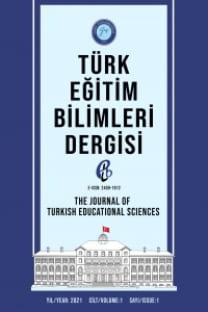ÖĞRETMEN KAVRAMI İLE İLGİLİ METAFORLARA İLİŞKİN ÖĞRENCİ, ÖĞRETMEN VE YÖNETİCİLERİN GÖRÜŞLERİ
Bu araştırmanın temel amacı, öğretmen kavramına ilişkin öğrenci, öğretmen ve yöneticilerin sahip oldukları algıları, metaforlar kullanılarak analiz etmektir. Araştırmanın çalışma alanını 2004-2005 eğitim ve öğretim yılında Bolu ili merkez ilçe sınırları içerisinde bulunan 19 ilköğretim okulunda beşinci sınıfta okuyan 600 öğrenci, görev yapan 203 öğretmen ve 51 yönetici oluşturmuştur. Araştırmada veriler anket yoluyla elde edilmiştir. Öğretmen kavramına ilişkin metaforların tercih edilme düzeyleri frekans, yüzde, aritmetik ortalama ve standart sapma kullanılarak belirlenmiştir. Katılımcıların cinsiyetlerine göre görüşleri arasındaki farklılık t-testi, öğretmen ve yöneticilerin kıdemleri ve eğitim durumlarına göre görüşleri arasında farklılık ise tek yönlü varyans analizi ile test edilmiştir. Çalışmada elde edilen sonuçlar şunlardır: Öğretmenin bilgi kaynağı ve dağıtıcısı, anne/baba, arkadaş, rehber ve çevresini aydınlatan kişi olduğu metaforları kabul edilirken, öğretmenin bahçıvan, otoriter kişi, bakıcı, gardiyan, yıkıcı ve zarar verici kişi olduğu metaforları ise tercih edilmemiştir. Öğrenci, öğretmen ve yöneticilerin görüşleri arasında cinsiyete göre farklılık bulunmamıştır. Öğretmen ve yöneticilerin eğitim durumlarına ve mesleki kıdemlerine göre farklılık ortaya çıkmamıştır. Öğrenciler ile öğretmen ve yöneticilerin konuyla ilgili görüşleri arasında ise anlamlı fark olduğu tespit edilmiştir.
Anahtar Kelimeler:
Öğretmen, metafor, öğretmen kavramına ilişkin metaforlar
STUDENTS, TEACHERS AND ADMINISTRATORS’ VIEWS ON METAPHORS WITH RESPECT TO THE CONCEPT OF TEACHER
The purpose of this study is to determine the metaphors that the students, teachers and administrators formulated to describe the concept of teacher. The sample of study includes 600 primary school students, 203 teachers and 51 administrators working at primary schools in 2004-2005 academic year. The data of the study were gathered through the questionnaires. Frequencies, percent, mean, standard deviation, ttest and one-way analysis of variance (ANOVA) were used for statistical analyses. The results obtained in this study are as follows: Although metaphors for teachers as being a source of knowledge, distributor, father/mother, friend, guide and person enlightening the others is accepted, the metaphors for them as being a gardener, authoritarian, keeper, guard and demolisher, harmful person have not been accepted. When the results are taken into account, there are some significant differences in students, teachers, and administrators perspectives whereas their perspectives do not have significant differences in gender, educational level, and years of seniority.
___
- Achinstein, B. ve Barrett, A. (2004). (Re) Framing classroom contexs: How teachers and mentors view diverse learners and challenges of practice. Teachers College Record, 16(4), 716-746.
- Alexander, P., Fives, H., Buehl, M. M. ve Mulhern, J. (2002). Teaching as persuasion. Teaching and Teacher Education, 18, 795-813.
- Arnett, R. C. (1999). Metaphorical Guidance: Administration as building and renovation. Journal of Educational Administration, 37(1), 80-89.
- Atalay, S. (1996). Bilgi toplumu öğretmenlerinin sorunları. Modern Öğretmen Yetiştirmede Gelişme ve İlerlemeler Sempozyumunda Sunulan Bildiri, Hacettepe Üniversitesi, Ankara.
- Baker, C. (1995). Zorunlu eğitime hayır. (Çev: Ayşegül Sönmezay). İstanbul: Ayrıntı Yayınları.
- Baker, P.S. (1991). Metaphors of mindful engament and a vision of beter schools. Educational Leadership, April, 32-35.
- Balcı, A. (2001,). Öğrenci, öğretmen ve velilerin okul kavramlaştırmaları: okul’un metaforik bir analizi. X. Ulusal Eğitim Bilimleri Sempozyumu, Abant izzet Baysal Üniv., Bolu.
- Ben-Peretz, M., Mendelson, N. ve Kron, F. W. (2003). How teachers in different educational context view their roles. Teaching and Teacher Education, 19, 277-290.
- Cook-Sather, A. (2003). Movements of mind: The matrix, metaphors and re-imaging education. Teachers College Record, 105(6), 946-977.
- Erdem, F. ve Şatır, Ç. (2000, Mayıs). Farklı örgütlerde kültürel yapının metaforlarla analizi. VIII. Ulusal Yönetim ve Organizasyon Kongresi, Erciyes Üniversitesi, Nevşehir.
- Goldstein, L. B. (2005). Becoming a teacher as a hero’s journey: Using metaphor in preservice teacher education. Teacher Education Quarterly, 32(1), 7-24.
- Gürkan, T. (1993). İlkokul öğretmenlerinin öğretmenlik tutumları ve benlik kavramları arasındaki ilişki. Ankara: Sevinç Matbaası.
- Inbar, D. E. (1996). The Free Educational Prison: Metaphors and Images. Educational Research, 38(1), 77-92.
- Lakoff, G. ve Johnson, M. (2005). Metaforlar hayat, anlam ve dil. (Çev: G. Y. Demir). İstanbul: Paradigma Yayınları.
- Mahlios, M. ve Maxson, M. (1998). Metaphors as structures for elementary and secondary preservice teachers’ thinking. International Journal of Educational Research, 29, 227-240.
- Morgan, G. (1998). Yönetim ve örgüt teorilerde metafor. (Çev: G. Bulut). İstanbul: MESS Yayınları.
- Oktay, A. (2004). 21. yüzyılda yeni eğilimler ve eğitim. İçinde: Ed: O. Oğuz ve A. Oktay, 21.Yüzyılda Eğitim ve Türk Eğitim Sistemi. İstanbul: Dem Yayınları.
- Oxford, R., Tomlinson, S., Barcelos, A., Harrington, C., Lavine, R., Saleh, A. ve Longhini, A. (1998). Clashing metaphors about classroom teachers: Toward asystematic typology for the language teaching field. System, 26, 3-50.
- Özden, Y. (2002). Eğitimde yeni değerler. Ankara: Pegem A Yayıncılık
- Pipen, T. (2001). Metaphors and organizational identity in the Italian puplic services. Scandinavian Journal of Management, 16, 391-409.
- Saban, A. (2003). A Turkish Profile of prospective elemantery school teachers and their views of teaching. Teaching and Teacher Education, 19(8), 829-846.
- Saban, A. (2004). Prospective classroom teachers’ metaphorical images of selves and comparing them to those they have of their elemantery and cooperating teachers. International Journal of Educational Development, 24, 617-635.
- Saban, A., Koçbeker, B. N. ve Saban, A. (2007). Prospective teachers’ conceptions of teaching and learning revealed through metaphor analysis. Teaching and Teacher Education, 17, 123-139.
- Tsoukas, H. (1991). The missing link: Atransformational view of metaphors in organizational science. The Academy of Management Review, 16(3), 566-585.
- Wasley, P. A. (1991). From quarterback to coach, from actor to director. Educational Leadership, 35-40.
- Başlangıç: 2003
- Yayıncı: ANKARA HACI BAYRAM VELİ ÜNİVERSİTESİ
Sayıdaki Diğer Makaleler
TÜRKÇE ÖĞRETMEN ADAYLARININ DEMOGRAFİK ÖZELLİKLERİ
Yapılandırmacı Öğrenme Yaklaşımının Duyuşsal ve Bilişsel Öğrenme Ürünlerine Etkisi
Melek DEMİREL, Gürcü ERDAMAR KOÇ
YAPILANDIRMACI ÖĞRENME YAKLAŞIMININ DUYUŞSAL VE BİLİŞSEL ÖĞRENME ÜRÜNLERİNE ETKİS
Gürcü ERDAMAR KOÇ, Melek DEMİREL
ORTAÖĞRETİM OKULLARINDA ÖRGÜTSEL SAĞLIK İLE ÖRGÜTSEL VATANDAŞLIK DAVRANIŞLARI ARASINDAKİ İLİŞKİ
ÖĞRETMEN KAVRAMI İLE İLGİLİ METAFORLARA İLİŞKİN ÖĞRENCİ, ÖĞRETMEN VE YÖNETİCİLERİN GÖRÜŞLERİ
MATEMATİK ÖĞRETMENLERİNİN ÖĞRETİMLERİNE YÖNELİK ÖZ-YETERLİK İNANÇLARI
